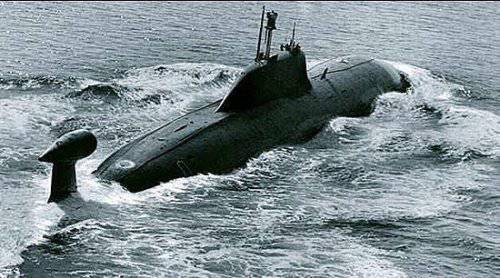In the West, have guessed why the Russian nuclear submarine followed the English SSBN
Russian nuclear submarines use passive sonars, which listen for sounds and match them with a pre-recorded acoustic database. The fact is that the Russian database has long been in need of updating, since in the past two decades submarines have rarely set sail. On average, Russian nuclear submarines annually went to sea ten times (shock submarines more often, strategic submarines less often). Some boats went out to sea for only a few days, and some even for only a few hours. At the same time, US nuclear boats carry out every naval patrol with duration from 2 to 6 months.
Each surface ship, submarine or sea animal has its own specific noise, which must be stored in the database. Some US databases have such extensive acoustic information that can be used to identify even individual marine animals from the same class of mammals. If in the 1984 year, the Soviet fleet conducted 230 patrols of nuclear submarines, then since 1990-s their number has declined sharply. The mistake of the Russian admirals was that they tried to keep a larger number of ships, although it was necessary to remove the 90% of the ship's composition from the composition, and to keep the rest in a more or less decent condition. Most of the naval budget went to the maintenance of promptly unused ships and submarines.
Currently, Russia has 14 SSBNs, but not all of them have a full set of ballistic missiles. Some submarines lack crew members, some boats do not have key onboard systems. The Russian Navy has only 8 modern shock submarines of the Akula class (NATO code, 971 Ave. Pike-B - approx. Lane) with a displacement of 7000 t (one of them must be leased to the Indian Navy). These submarines began to be built at the end of the 80-ies, and their combat characteristics are comparable to the American submarines of the Los Angeles class. All previously built Russian nuclear submarines turned into "garbage", most of them were decommissioned. There are also 8 heavy percussion submarines equipped with a CU, and 20 diesel-electric boats. A new type of submarine submarine with a CD is being developed, but progress is too slow.
The U.S. Navy currently has 7 of the latest Virginia-class strike submarines with a displacement of 7700 tons, three more are at different stages of construction (it is planned to have 30 nuclear submarines of this type in total). The basis of the American multipurpose submarine forces is still Los Angeles class submarines with a displacement of 6100 tons (there are 44 boats in the combat strength, a total of 62 units were built). There are also three powerful Seawolf class strike submarines (the construction program for a total of 29 boats of this class was canceled due to the disappearance of the Soviet fleet) These super boats were supposed to fight the Soviet Navy at the peak of its heyday.
The service life of Western submarines is approximately 30 years, Russian submarines rarely live to 20-year service life. To maintain the number of submarines of all classes at the level of 40 units, the Russian Navy should receive two (or submarines or SSBNs) annually, which seems unrealistic without proper multi-billion funding. Currently, priority is given to the construction of new Borey-class strategic submarines (under construction or more than 11 boats of this type are planned). Russian submarines go to sea in the 3-4 times more often than 20 years ago, but still this is not enough to achieve Western standards. But it should still be noted that the Russian Navy has stopped its fall in a spiral.

Information